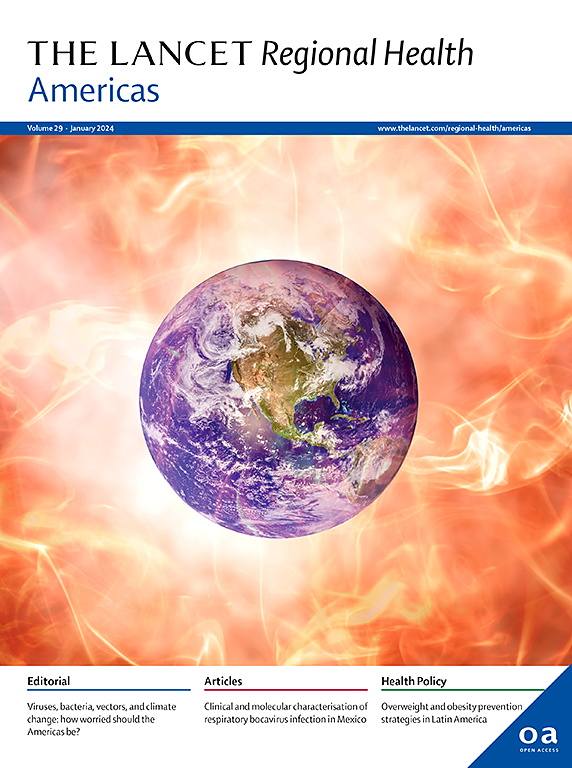Effects of an urban cable car intervention on quality of life: an observational, quasi-experimental study in Bogotá, Colombia (TrUST)
IF 7
Q1 HEALTH CARE SCIENCES & SERVICES
引用次数: 0
Abstract
Background
There is little evidence about the relationships between transport interventions and quality of life in low-income settlements in Global South cities. The aim was to assess the effects of the TransMiCable cable car intervention on quality of life in males and females in a low-income settlement in Bogotá, Colombia.
Methods
The Urban Transformations and Health (TrUST) natural experiment was conducted between 2018 and 2020 in intervention and control neighbourhoods. Overall quality of life, general health, and specific domains of quality of life were assessed in adults before and after the implementation of the TransMiCable using the World Health Organization's quality of life brief questionnaire. Adjusted multilevel linear regression models were used to estimate the effects on outcomes.
Findings
Before the inauguration of TransMiCable, 2052 participants (1289 [62.8%] females and 763 [37.2%] males; mean age 43.5 years [SD 17.7]) completed the questionnaire. Analyses included 825 participants in the intervention group (80% of the baseline sample) and 854 participants in the control group (84% of the baseline sample) who completed the follow-up. Among females in the intervention area, there was an increase in quality of life (adjusted β for the time-by-group interaction, intervention vs. control: 5.81 points [95% CI: 2.47, 9.14]), and general health (adjusted β for the time-by-group interaction: 5.49 points [2.07, 8.92). Among males, quality of life and general health changes were not different in the intervention and control groups.
Interpretation
Transport interventions, such as TransMiCable, could have meaningful impacts on the quality of life of women in low-income areas, promoting the achievement of sustainable development goals and improving well-being. A community-based, multisectoral approach is essential to designing integrated mobility policies that reflect the diverse needs of urban communities in the Global South.
Funding
Wellcome Trust (as part of the Urban Health in Latin America project); Bogotá Urban Planning Department; Ministry of Science, Technology, and Innovation of Colombia; Universidad de Los Andes; Fundación Santa Fe de Bogotá; and Universidad del Norte.
城市缆车干预对生活质量的影响:哥伦比亚波哥大的一项观察性、准实验研究(TrUST)
在全球南方城市的低收入住区中,关于交通干预与生活质量之间关系的证据很少。目的是评估TransMiCable缆车干预对哥伦比亚波哥大一个低收入定居点男性和女性生活质量的影响。方法2018 ~ 2020年在干预对照社区开展城市转型与健康(TrUST)自然实验。在实施TransMiCable之前和之后,使用世界卫生组织的生活质量简要问卷对成年人的总体生活质量、一般健康状况和特定生活质量领域进行了评估。采用调整后的多水平线性回归模型估计对结果的影响。在TransMiCable启动前,共有2052名参与者,其中女性1289人(62.8%),男性763人(37.2%);平均年龄43.5岁[SD 17.7])完成问卷调查。分析包括825名干预组参与者(基线样本的80%)和854名对照组参与者(基线样本的84%),他们完成了随访。在干预区的女性中,生活质量(干预组与对照组按时间相互作用调整的β值:5.81分[95% CI: 2.47, 9.14])和一般健康状况(按时间相互作用调整的β值:5.49分[2.07,8.92])均有所提高。在男性中,干预组和对照组的生活质量和总体健康变化没有差异。TransMiCable等交通干预措施可以对低收入地区妇女的生活质量产生有意义的影响,促进实现可持续发展目标并改善福祉。以社区为基础的多部门方法对于设计反映全球南方城市社区多样化需求的综合交通政策至关重要。为威康信托基金提供资金(作为拉丁美洲城市卫生项目的一部分);波哥大城市规划部;哥伦比亚科学、技术和创新部;洛斯安第斯大学;Fundación圣达菲波哥大;和北方大学。
本文章由计算机程序翻译,如有差异,请以英文原文为准。
求助全文
约1分钟内获得全文
求助全文
来源期刊

Lancet Regional Health-Americas
Multiple-
CiteScore
8.00
自引率
0.00%
发文量
0
期刊介绍:
The Lancet Regional Health – Americas, an open-access journal, contributes to The Lancet's global initiative by focusing on health-care quality and access in the Americas. It aims to advance clinical practice and health policy in the region, promoting better health outcomes. The journal publishes high-quality original research advocating change or shedding light on clinical practice and health policy. It welcomes submissions on various regional health topics, including infectious diseases, non-communicable diseases, child and adolescent health, maternal and reproductive health, emergency care, health policy, and health equity.
 求助内容:
求助内容: 应助结果提醒方式:
应助结果提醒方式:


